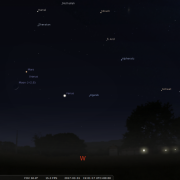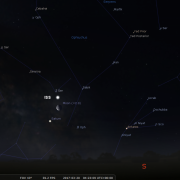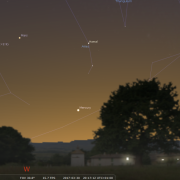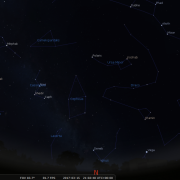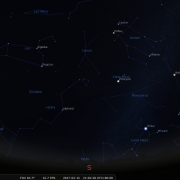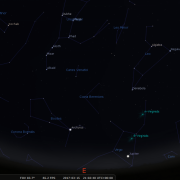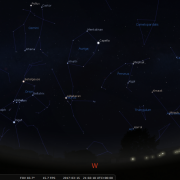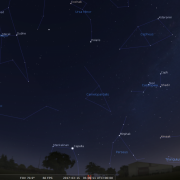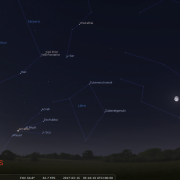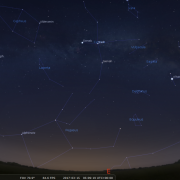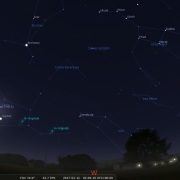In this month's Sky Notes:
Planetary Skylights

 Venus continues to dominate the evening sky – an unmistakeable beacon over in the SW. The crescent moon lies close to Venus on the first day of the month making for a pleasing visual treat, especially as Mars is also in the vicinity, indeed Venus and Mars are closest in the sky the following evening. Mars resembles an ochre star upper left of Venus.
Venus continues to dominate the evening sky – an unmistakeable beacon over in the SW. The crescent moon lies close to Venus on the first day of the month making for a pleasing visual treat, especially as Mars is also in the vicinity, indeed Venus and Mars are closest in the sky the following evening. Mars resembles an ochre star upper left of Venus.
 As Venus descends, so Mercury climbs into the sky from mid month onwards, it’s best evening apparition of the year. Look for the elusive inner most planet at the back end of March from the 26th and into April. By then Venus will have all but departed, so the moon must serve as a guide to Mercury’s whereabouts. A thin crescent moon lies due west on the 29 and 30th, you will need to search in the evening twilight around 45 minutes after sunset. Locate the crescent and look a few degrees to the right at a similar height. If you spot what resembles a bright star you have tracked down Mercury. Use binoculars if you cannot initially spot it with the naked eye.
As Venus descends, so Mercury climbs into the sky from mid month onwards, it’s best evening apparition of the year. Look for the elusive inner most planet at the back end of March from the 26th and into April. By then Venus will have all but departed, so the moon must serve as a guide to Mercury’s whereabouts. A thin crescent moon lies due west on the 29 and 30th, you will need to search in the evening twilight around 45 minutes after sunset. Locate the crescent and look a few degrees to the right at a similar height. If you spot what resembles a bright star you have tracked down Mercury. Use binoculars if you cannot initially spot it with the naked eye.
 Mars also resides low in the WSW upper left of Venus and Mercury. The red planet is readily visible to the naked eye and resembles an ‘ochre’ hued star. Telescopically Mars is well past its best for this apparition. View on the 1st when a crescent moon lies below and again on the 30th when Mars, Moon and Mercury form a triangle.
Mars also resides low in the WSW upper left of Venus and Mercury. The red planet is readily visible to the naked eye and resembles an ‘ochre’ hued star. Telescopically Mars is well past its best for this apparition. View on the 1st when a crescent moon lies below and again on the 30th when Mars, Moon and Mercury form a triangle.
 As Mars and Mercury set around 9pm, so Jupiter emerges into the spring sky across in the east. Look for a very conspicuous beacon low in the SE. Currently Jupiter resides in the spring constellation of Virgo, above its chief star Spica. This means as night’s grow lighter, telescopic observations will be limited to the late evenings or even early mornings when Jupiter is higher to the south. Fortunately Jupiter always has something to offer, even for smaller apertures. Look for the banding on the disk and the attendant Galilean moons. On the 15th a waning crescent moon resides upper left of Jupiter.
As Mars and Mercury set around 9pm, so Jupiter emerges into the spring sky across in the east. Look for a very conspicuous beacon low in the SE. Currently Jupiter resides in the spring constellation of Virgo, above its chief star Spica. This means as night’s grow lighter, telescopic observations will be limited to the late evenings or even early mornings when Jupiter is higher to the south. Fortunately Jupiter always has something to offer, even for smaller apertures. Look for the banding on the disk and the attendant Galilean moons. On the 15th a waning crescent moon resides upper left of Jupiter.
 Finally, Saturn rises in early morning hours and is best viewed telescopically around 4-5am low to the south. Saturn resides to the left of bright Antares, chief star of Scorpius. Look on the 20th when a waning crescent moon lies upper right of Saturn.
Finally, Saturn rises in early morning hours and is best viewed telescopically around 4-5am low to the south. Saturn resides to the left of bright Antares, chief star of Scorpius. Look on the 20th when a waning crescent moon lies upper right of Saturn.
Meteor Showers and Comets

No major showers this month; however at the very end of March you may spot a few Viginids, which are slow moving and have long paths. (Make up your own jokes) As usual early morning hours are best to spot any meteors. There are no comets readily visible this month.
March 2017 Sky Charts
Click each image to see a full-size Sky Chart:
Additional Image Credits:
- Planets and Comets where not otherwise mentioned: NASA
- Sky Charts: Stellarium Software
- Log in to post comments

